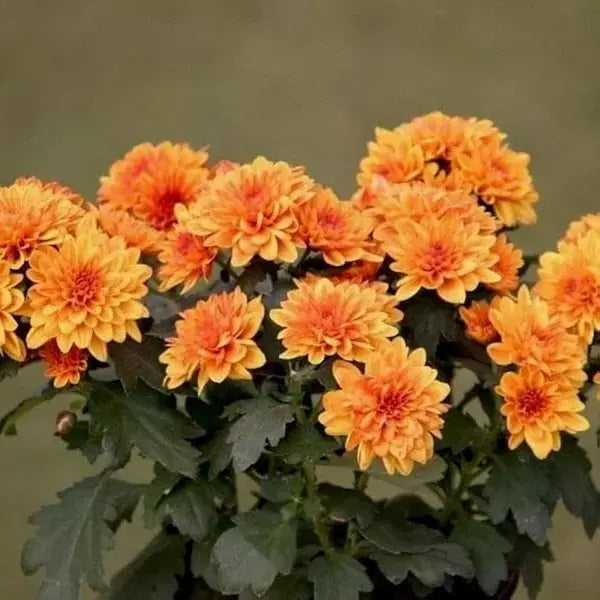
Jamanthi,Chrysanthemum Orange - Rare
Selling Size : Bushy Plant | Pot Included | Secuire Packing
"Jamanthi" is the common name for Chrysanthemum in India, particularly in South India. So, "Jamanthi Chrysanthemum Orange - Rare" refers to a rare orange-colored variety of Chrysanthemum. While some varieties might be less common than others, the general care for Chrysanthemums remains largely the same.
Chrysanthemums (Mums) are popular for their vibrant, long-lasting blooms, especially in the autumn and winter months, making them a staple in Indian gardens during festive seasons like Diwali.
Here's a comprehensive care guide for your Jamanthi Chrysanthemum Orange - Rare:
1. Sunlight:
Full sun is essential for abundant blooms. Jamanthi needs at least 6 hours of direct sunlight per day to thrive and produce its characteristic vibrant flowers.
In hot Indian summers, especially during peak afternoon heat, some partial shade might be beneficial to prevent scorching of leaves and flowers. However, ensure it still gets plenty of morning sun.
Insufficient light will lead to leggy growth and significantly fewer, or no, blooms.
2. Watering:
Consistent moisture is key, but avoid waterlogging. Jamanthi plants are heavy drinkers, especially when in bloom and during warmer months.
Water thoroughly when the top inch or two of soil feels dry. For potted plants, this might mean daily or every other day, especially in hot weather.
Water at the soil level to prevent fungal diseases on the foliage and blooms. Avoid overhead watering.
Ensure your pots have excellent drainage holes. Sitting in soggy soil will quickly lead to root rot.
Reduce watering frequency in cooler weather or when the plant is dormant.
3. Soil:
Jamanthi prefers well-draining, fertile soil rich in organic matter.
A good potting mix for containers can be a blend of garden soil, compost, and some sand or perlite to improve drainage.
For garden beds, amend heavy clay soils with compost or well-rotted manure to improve drainage and fertility.
The ideal soil pH is slightly acidic to neutral (6.0-8.0).
4. Temperature:
Chrysanthemums thrive in moderate temperatures.
Ideal daytime temperatures are around 21-27°C (70-80°F).
They prefer cooler nights, ideally around 15-18°C (60-65°F), which helps in bud formation and intense bloom color.
While they can tolerate some heat, prolonged high temperatures can sometimes delay blooming. In very hot climates, consider providing afternoon shade.
They are quite hardy and can tolerate temperatures down to freezing, but protecting them from severe frost is advisable, especially for potted plants.
5. Fertilization:
Jamanthi are heavy feeders, especially during their active growing and blooming phases.
During the growing season (spring and summer/monsoon in India), fertilize every 2-4 weeks.
Use a balanced liquid fertilizer or a granular fertilizer with a slightly higher phosphorus (P) content to encourage flowering.
Organic options like well-rotted cow manure or vermicompost can be incorporated into the soil or used as a top dressing.
Reduce or stop fertilizing during the dormant period (winter after blooming).
6. Pruning and Pinching:
Pinching is crucial for a bushy plant and more blooms.
When your Jamanthi plant is about 6-8 inches tall (usually in spring), pinch off the top inch of the main stem and side shoots. This encourages branching.
Repeat this pinching every 2-3 weeks until early to mid-monsoon (around July-August in India). Stop pinching after this time to allow the plant to set buds for autumn/winter flowering.
Deadheading: Regularly remove spent or faded flowers (deadheading). This encourages the plant to produce more blooms and keeps it looking tidy.
Post-bloom pruning: After the blooming season is over (usually late winter/early spring), you can prune the plant back significantly (e.g., to about 6-8 inches from the ground) to encourage new, vigorous growth for the next season.
7. Pests and Diseases:
Common pests include aphids, spider mites, and thrips. Inspect your plants regularly.
Treat infestations with insecticidal soap, neem oil, or strong blasts of water from a hose.
Fungal diseases like powdery mildew or rust can occur, especially in humid conditions with poor air circulation. Ensure good air circulation, avoid overhead watering, and if necessary, use a fungicide.
Root rot is a common issue caused by overwatering and poor drainage.
8. Propagation:
Jamanthi can be easily propagated by cuttings taken in spring or early monsoon.
You can also propagate by division of mature clumps in early spring.
9. Overwintering (for perennial varieties):
Many Jamanthi varieties are perennial. If you want to keep them for successive years:
After the blooming season and pruning, if the climate gets very cold (below freezing), you can mulch heavily around the base of the plant to protect the roots.
For potted plants, move them to a sheltered, cool, and dark location (like a garage or shed) for the winter. Keep the soil slightly moist, but don't overwater.
Special Note for "Rare" varieties: While the basic care remains the same, a "rare" variety might be more sensitive to specific conditions or might simply be less common due to slower propagation rates or specific aesthetic qualities. Always observe your plant closely for any signs of stress and adjust care as needed.
By providing these optimal conditions, your Jamanthi Chrysanthemum Orange - Rare should flourish and provide you with beautiful, vibrant blooms!

